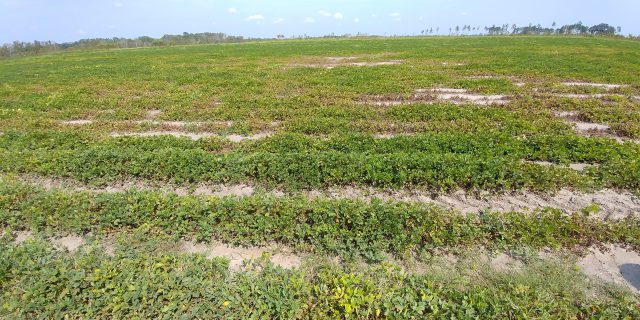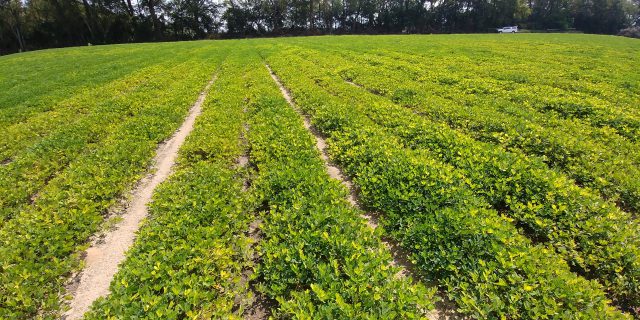I’ve had the opportunity to visit a number of grower fields this summer to assess potential nematode damage and I’ve often been asked this question: “Why is nematode damage worse in one section of a field than another, or worse in one field than another one nearby? ” This question reflects the fact that nematode population densities and damage are often patchy both within a field and between different fields.

Patchy necrosis (dead or dying plants) and chlorosis (yellowing) in a peanut field with severe root-knot nematode infestation.
There are a number of reasons nematode infestations or damage is often patchy:
-
Management history
This is an important factor for variation between fields. Factors such as crop rotation, cover crop use, weed management, nematicide use, use of resistant cultivars, and other practices all affect nematode populations. Nematodes need a living host crop to feed on and reproduce, so nematode populations will be higher in areas where a host cash crop, cover crop, or weed has grown.
-
Nematode dispersal is (usually) relatively slow
Nematodes don’t move far on their own. Rather, they are moved by human or natural activity, often slowly. Nematodes are moved to new fields or moved within a field on farm equipment, infected plant material, or water or wind-born soil. Therefore, a new nematode infection in a field often starts from a single point, such as near a field entrance, and spreads relatively slowly.
-
Field variation in soil type and other properties or features
Soil properties such as soil type, temperature, and moisture can affect nematode reproduction, and when these factors vary within or between fields, nematode population densities do as well. Most nematodes prefer sandy soil, and are more likely to thrive in sandy fields or sandy patches within a field. One exception is reniform nematode which tends to do best with moderate amounts of sand (70-80%) and is a pathogen of cotton, soybean, and most vegetables. Nematodes prefer a moderate amount of moisture and relatively high temperatures, so if these factors vary across a field, perhaps due to hills and valleys, nematode populations may vary as well.
-
Field variation in crop health, weeds, pathogens, biocontrol organisms, and other biological factors
Crop health can also affect the severity of nematode damage, as a healthy plant can better withstand nematode infection than a plant stressed by nutrient deficiency, drought, competition from weeds, or other factors that can vary across a field. Similarly, crop damage is often increased when soil-borne pathogens and nematodes co-infect. A number of soil-borne bacteria and fungi are known to kill nematodes and could act as natural biocontrol agents, helping keep nematode populations low. Variation in populations of pathogens and biocontrol agents across fields may contribute to nematode damage or population variation.
Knowledge of population density should influence nematode management practices in a number of ways:
-
Work to control the spread of nematodes
Because human activity is one of the main ways nematodes are moved, human actions can help slow nematode spread, especially from field to field. Use nematode-free planting material, don’t move plant material from field to field, and wash equipment free of soil when possible.
-
Account for field variation when sampling for nematodes
Sampling for nematodes is an important part of a nematode management strategy. When sampling for nematodes, sample areas at high risk of nematode damage (sandy, poor fertility) separately from areas at lower risk of damage. This could coincide with soil mapping, such as with a Veris rig or soil type maps, and division into management zones.
-
Spot-treat areas with nematode problems
Once a field is infected, nematode management relies on crop rotation, resistant cultivars, and nematicide application. Particularly for expensive, high-input nematode management practices such as nematicide application, treating only the areas of a field with nematode problems can save time and money. Ideally, areas with nematode problems should be identified by sampling and could coincide with management zones based on soil properties.
-
Promote crop health and manage weeds
Soil type and other factors that affect nematode distribution are hard to control, but growers have some control over crop health and weeds. A healthy crop is more tolerant of nematodes, so properly fertilized crops and the use of other practices to promote vigor can reduce yield losses. As discussed above, weeds also harbor nematodes, so it is important to manage weeds early.—
Further information and resources can be found in the following UF/IFAS EDIS fact sheets:
Sampling for nematodes
Florida cotton nematode management guide
Nematode management in tomatoes, peppers, and eggplant
Precision agriculture
- Salibro: A Recently-Registered Conventional Nematicide for Select Horticulture Crops - March 7, 2025
- What Cotton Cultivars have Resistance or Tolerance to Southern Root-knot and Reniform Nematode? - February 28, 2025
- How Well Do Root-Knot Nematode Resistant Peanut Cultivars Perform in Florida? - February 14, 2025

